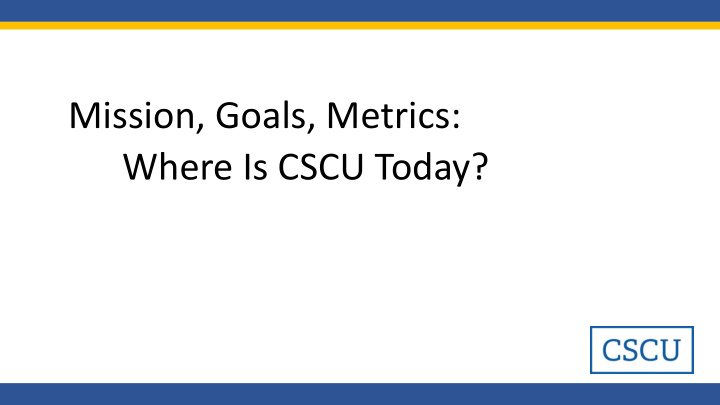



Mission, Goals, Metrics: Where Is CSCU Today?
CSCU Mission & Goals History BOR adopted the mission and goals - June 2013 • Mission & goals development included a wide array of • stakeholders In addition to the CSCU Mission , each constituent unit • of CSCU has its own distinct mission.
CSCU Mission The Connecticut State Colleges & Universities (CSCU) contribute to the creation of knowledge and the economic growth of the state of Connecticut by providing affordable, innovative, and rigorous programs. Our learning environments transform students and facilitate an ever increasing number of individuals to achieve their personal and career goals.
CSCU Goals 1. A Successful First Year – Increase the number of students who successfully complete a first year of college 2. Student Success – Graduate more students with the knowledge & skills to achieve their life and career goals 3. Affordability & Sustainability – Maximize access to higher education by making attendance affordable and our institutions financially sustainable 4. Innovation & Economic Growth – Create educational environments that cultivate innovation and prepare students for successful careers in a fast changing world 5. Equity – Eliminate achievement disparities among different ethnic/racial, economic and gender groups
A Successful First Year PCT Successfully (C or better) Completing College-Level Math/English in First Year Base: New Community College Students 50% 45% 45% 45% 44% 43% 41% 41% 40% 35% 30% 29% 28% 27% 27% 26% 26% 25% 22% 22% 21% 21% 20% 20% 20% 15% 10% 5% 0% 2013 2014 2015 2016 2017 2018 Math English Math & Eng
A Successful First Year – First to Second Year Retention of First-time Full-time Connecticut State University Students Percent Retained Year of First 2013 2014 2015 2016 2017 2018 Enrollment Central 77 (75)* 78 (75) 78 (74) 76 (75) 74 (74) 72 Eastern 78 (75) 77 (76) 76 (73) 77 (72) 80 (72) 77 Southern 75 (75) 75 (76) 77 (74) 78 (76) 72 (73) 73 Western 74 (77) 79 (77) 73 (76) 73 (77) 74 (74) 74 * Number in parentheses is the average retention rate of peer institutions. 2019 Source: IPEDS Data Feedback Reports and CSU IR Offices
Student Success – CCC Graduation and Transfer Rates 40.0% 36.0% Grad rate + 34.0% 34.3% 33.5% 33.3% 35.0% Transfer-out rate = Success rate 30.0% 20.5% 25.0% 18.8% 17.5% 19.4% 21.1% 20.0% 15.0% 10.0% 15.8% 15.5% 15.5% 14.6% 12.5% 5.0% 0.0% 2012 cohort 2013 cohort 2014 cohort 2015 cohort 2016 cohort Grad Rate Transfer Rate
Student Success – CSU Six-Year Graduation Rates
Student Success – Post Graduation Employment The majority of CSCU students work in Connecticut shortly after graduation. CSU, CC and COSC graduates continue to find employment in CT. The overall employment rates three quarters after graduation are stable for CSU and CC graduates, and the percent of COSC graduates working in CT increased by 10% over the past 9 years. Source: Connecticut State Colleges & Universities, Employment & Wages, Sector Charts Graduates from 2009-10 to 2018-19, P20 WIN Release 2020.02
Affordability & Sustainability Median Tuition + Fees at CCC and Peer Schools in Neighboring New England States over Time CT Community Colleges Massachusetts Peers Rhode Island Peer
Affordability & Sustainability Median Tuition + Fees at CSUs and Peer Schools in Neighboring New England States over Time CSUs Massachusetts Peers Rhode Island Peer
Innovation & Economic Growth High Workforce Demand Completions by Year 3500 Completions in high workforce 3070 3070 demand programs constitute 2775 2770 2889 2833 3000 2834 2798 approximately: 2658 2714 • 40% of all certificates and 2500 degrees in the community colleges; 2000 • 38% of the degrees awarded at the CSUs; and, 1500 • 14% of the completions in Charter Oak. 1000 500 79 58 53 50 42 0 2013-14 2014-15 2015-16 2016-17 2017-18 CCC CSU COSC
Equity— Community College Success Rates by Race/Ethnicty Grad Rate + Transfer Rate=Success Rate The achievement gap 50% 48% persists when Asian and 43% 45% 42% 41% 41% white outcomes are 42% 40% 39% 39% 39% compared to minority 35% 34% 30% groups historically under- 30% 30% 29% 27% represented in higher 27% 27% 28% 26% 25% 25% 25% education. 20% 15% 10% 5% 0% 2014-15 2015-16 2016-17 2017-18 2018-19 Asian Blk/Af-Am Latino White
2019: Where Students Earn Degrees in Connecticut Source: National Center for Education Statistics, IPEDS
Questions?
Recommend
More recommend